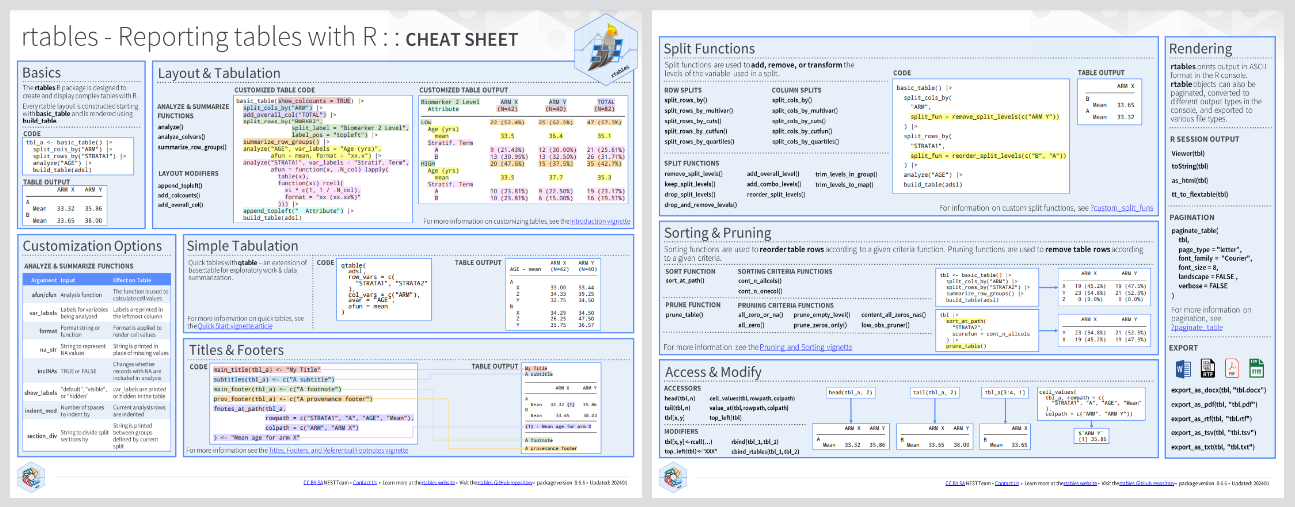The rtables R package was designed to create and display complex
tables with R. The cells in an rtable may contain any high-dimensional
data structure which can then be displayed with cell-specific formatting
instructions. Currently, rtables can be outputted in ascii html,
and pdf, as well Power Point (via conversion to flextable objects).
rtf support is in development and will be in a future release.
rtables is developed and copy written by F. Hoffmann-La Roche and it
is released open source under Apache License Version 2.
rtables development is driven by the need to create regulatory ready
tables for health authority review. Some of the key requirements for
this undertaking are listed below:
- cell values and their visualization separate (i.e. no string based
tables)
- values need to be programmatically accessible in their non-rounded state for cross-checking
- multiple values displayed within a cell
- flexible tabulation framework
- flexible formatting (cell spans, rounding, alignment, etc.)
- multiple output formats (html, ascii, latex, pdf, xml)
- flexible pagination in both horizontal and vertical directions
- distinguish between name and label in the data structure to work with
CDISCstandards - title, footnotes, cell cell/row/column references
rtables currently covers virtually all of these requirements, and
further advances remain under active development.
rtables is available on CRAN and you can install the latest released
version with:
install.packages("rtables")or you can install the latest development version directly from GitHub with:
remotes::install_github("insightsengineering/formatters")
remotes::install_github("insightsengineering/rtables")Note you might need to set your GITHUB_PAT environment variable in
order to be able to install from GitHub.
Packaged releases (both those on CRAN and those between official CRAN releases) can be found in the releases list.
We first demonstrate with a demographic table-like example and then show the creation of a more complex table.
library(rtables)
lyt <- basic_table() %>%
split_cols_by("ARM") %>%
analyze(c("AGE", "BMRKR1", "BMRKR2"), function(x, ...) {
if (is.numeric(x)) {
in_rows(
"Mean (sd)" = c(mean(x), sd(x)),
"Median" = median(x),
"Min - Max" = range(x),
.formats = c("xx.xx (xx.xx)", "xx.xx", "xx.xx - xx.xx")
)
} else if (is.factor(x) || is.character(x)) {
in_rows(.list = list_wrap_x(table)(x))
} else {
stop("type not supported")
}
})
build_table(lyt, ex_adsl)
#> A: Drug X B: Placebo C: Combination
#> ————————————————————————————————————————————————————————————
#> AGE
#> Mean (sd) 33.77 (6.55) 35.43 (7.90) 35.43 (7.72)
#> Median 33.00 35.00 35.00
#> Min - Max 21.00 - 50.00 21.00 - 62.00 20.00 - 69.00
#> BMRKR1
#> Mean (sd) 5.97 (3.55) 5.70 (3.31) 5.62 (3.49)
#> Median 5.39 4.81 4.61
#> Min - Max 0.41 - 17.67 0.65 - 14.24 0.17 - 21.39
#> BMRKR2
#> LOW 50 45 40
#> MEDIUM 37 56 42
#> HIGH 47 33 50library(rtables)
library(dplyr)
## for simplicity grab non-sparse subset
ADSL <- ex_adsl %>% filter(RACE %in% levels(RACE)[1:3])
biomarker_ave <- function(x, ...) {
val <- if (length(x) > 0) round(mean(x), 2) else "no data"
in_rows(
"Biomarker 1 (mean)" = rcell(val)
)
}
basic_table(show_colcounts = TRUE) %>%
split_cols_by("ARM") %>%
split_cols_by("BMRKR2") %>%
split_rows_by("RACE", split_fun = trim_levels_in_group("SEX")) %>%
split_rows_by("SEX") %>%
summarize_row_groups() %>%
analyze("BMRKR1", biomarker_ave) %>%
build_table(ADSL)
#> A: Drug X B: Placebo C: Combination
#> LOW MEDIUM HIGH LOW MEDIUM HIGH LOW MEDIUM HIGH
#> (N=45) (N=35) (N=46) (N=42) (N=48) (N=31) (N=40) (N=39) (N=47)
#> ————————————————————————————————————————————————————————————————————————————————————————————————————————————————————————————————————————————
#> ASIAN
#> F 13 (28.9%) 9 (25.7%) 19 (41.3%) 9 (21.4%) 18 (37.5%) 9 (29.0%) 13 (32.5%) 9 (23.1%) 17 (36.2%)
#> Biomarker 1 (mean) 5.23 6.17 5.38 5.64 5.55 4.33 5.46 5.48 5.19
#> M 8 (17.8%) 7 (20.0%) 10 (21.7%) 12 (28.6%) 10 (20.8%) 8 (25.8%) 5 (12.5%) 11 (28.2%) 16 (34.0%)
#> Biomarker 1 (mean) 6.77 6.06 5.54 4.9 4.98 6.81 6.53 5.47 4.98
#> U 1 (2.2%) 1 (2.9%) 0 (0.0%) 0 (0.0%) 0 (0.0%) 1 (3.2%) 0 (0.0%) 1 (2.6%) 1 (2.1%)
#> Biomarker 1 (mean) 4.68 7.7 no data no data no data 6.97 no data 11.93 9.01
#> BLACK OR AFRICAN AMERICAN
#> F 6 (13.3%) 3 (8.6%) 9 (19.6%) 6 (14.3%) 8 (16.7%) 2 (6.5%) 7 (17.5%) 4 (10.3%) 3 (6.4%)
#> Biomarker 1 (mean) 5.01 7.2 6.79 6.15 5.26 8.57 5.72 5.76 4.58
#> M 5 (11.1%) 5 (14.3%) 2 (4.3%) 3 (7.1%) 5 (10.4%) 4 (12.9%) 4 (10.0%) 5 (12.8%) 5 (10.6%)
#> Biomarker 1 (mean) 6.92 5.82 11.66 4.46 6.14 8.47 6.16 5.25 4.83
#> U 0 (0.0%) 0 (0.0%) 0 (0.0%) 0 (0.0%) 0 (0.0%) 0 (0.0%) 1 (2.5%) 1 (2.6%) 0 (0.0%)
#> Biomarker 1 (mean) no data no data no data no data no data no data 2.79 9.82 no data
#> UNDIFFERENTIATED 1 (2.2%) 0 (0.0%) 0 (0.0%) 0 (0.0%) 0 (0.0%) 0 (0.0%) 2 (5.0%) 0 (0.0%) 0 (0.0%)
#> Biomarker 1 (mean) 9.48 no data no data no data no data no data 6.46 no data no data
#> WHITE
#> F 6 (13.3%) 7 (20.0%) 4 (8.7%) 5 (11.9%) 6 (12.5%) 6 (19.4%) 6 (15.0%) 3 (7.7%) 2 (4.3%)
#> Biomarker 1 (mean) 4.43 7.83 4.52 6.42 5.07 7.83 6.71 5.87 10.7
#> M 4 (8.9%) 3 (8.6%) 2 (4.3%) 6 (14.3%) 1 (2.1%) 1 (3.2%) 2 (5.0%) 5 (12.8%) 3 (6.4%)
#> Biomarker 1 (mean) 5.81 7.23 1.39 4.72 4.58 12.87 2.3 5.1 5.98
#> U 1 (2.2%) 0 (0.0%) 0 (0.0%) 1 (2.4%) 0 (0.0%) 0 (0.0%) 0 (0.0%) 0 (0.0%) 0 (0.0%)
#> Biomarker 1 (mean) 3.94 no data no data 3.77 no data no data no data no data no dataWe would like to thank everyone who has made rtables a better project
by providing feedback and improving examples & vignettes. The following
list of contributors is alphabetical:
Maximo Carreras, Francois Collins, Saibah Chohan, Tadeusz Lewandowski, Nick Paszty, Nina Qi, Jana Stoilova, Heng Wang, Godwin Yung
- R in Pharma 2023
- R Medicine Virtual Conference 2023 [Video]
- Advanced rtables Training 2023 [Part 1 Slides] [Part 2 Slides]
- R in Pharma 2022 - Creating Submission-Quality Clinical Trial Reporting Tables in R with rtables [Slides] [Video]
- R Consortium 2022
- useR! 2020 - rtables Layouting and Tabulation Framework [Video]











